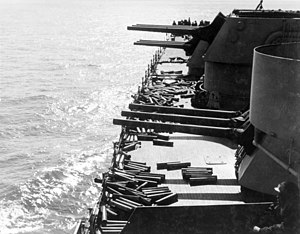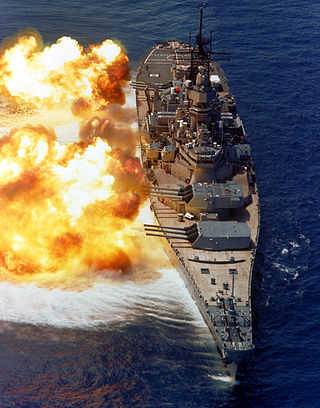
The 16"/50 caliber Mark 7 – United States Naval Gun is the main armament of the Iowa-class battleships and was the planned main armament of the canceled Montana-class battleship.

The Colorado-class battleships were a group of four United States Navy super-dreadnoughts, the last of its pre-Treaty battleships. Designed during World War I, their construction overlapped the end of that conflict and continued in its immediate aftermath. Though all four keels were laid, only three ships entered service: Colorado, Maryland, and West Virginia. Washington was over 75% completed when she was canceled under the terms of the Washington Naval Treaty in 1922. As such, the 16" gun Colorado-class ships were the last and most powerful battleships built by the U.S. Navy until the North Carolina class entered service on the eve of World War II.

The Courageous class consisted of three battlecruisers known as "large light cruisers" built for the Royal Navy during the First World War. The class was nominally designed to support the Baltic Project, a plan by Admiral of the Fleet Lord Fisher that was intended to land troops on the German Baltic Coast. Ships of this class were fast but very lightly armoured, with only a few heavy guns. They were given a shallow draught, in part to allow them to operate in the shallow waters of the Baltic but also reflecting experience gained earlier in the war. To maximize their speed, the Courageous-class battlecruisers were the first capital ships of the Royal Navy to use geared steam turbines and small-tube boilers.

The Pennsylvania class of six armored cruisers served in the United States Navy from 1905 to 1927. All six were renamed for cities 1912–1920, to make the state names available for the new battleships beginning with the Pennsylvania-class battleships. All of these served during World War I, with California being the only ship of the class to be lost. The remaining five armored cruisers were scrapped between 1930 and 1931 in accordance with the London Naval Treaty.
The P class was a planned group of twelve heavy cruisers of Nazi Germany's Kriegsmarine; they were the successor to the Deutschland-class cruisers. Design work began in 1937 and continued until 1939; at least twenty designs were submitted with nine of them being considered. There were three designs that were selected as the final contenders. One design was armed with six 283mm main guns in one triple turret forward and one more turret aft. It had two 150mm double secondary gun turrets as secondary armament with one being positioned above and just fore of the aft of the main 283mm main turret, and the other being in front and lower of the front main gun turret. This design had more beam than the other 2 designs. It also mounted 2 seaplanes on its fantail instead of the mid ship area. The final design was armed with six 28 cm (11 in) quick-firing guns in two triple turrets, as in the preceding Deutschland class. The ships were designated as Panzerschiff, and given the preliminary names P1–P12. They were an improved design over the preceding planned D-class cruisers, which had been canceled in 1934. Although the ships were already assigned to shipyards, construction never began on the P-class ships after the O-class battlecruiser design superseded them.

The 3-inch/50-caliber gun in United States naval gun terminology indicates the gun fired a projectile 3 inches (76 mm) in diameter, and the barrel was 50 calibers long. Different guns of this caliber were used by the U.S. Navy and U.S. Coast Guard from 1900 through to 1990 on a variety of combatant and transport ship classes.

The three Chester-class cruisers were the first United States Navy vessels to be designed and designated as fast "scout cruisers" for fleet reconnaissance. They had high speed but little armor or armament. They were authorized in January 1904, ordered in fiscal year 1905, and completed in 1908. In 1920 all scout cruisers were redesignated as "light cruisers" (CL).
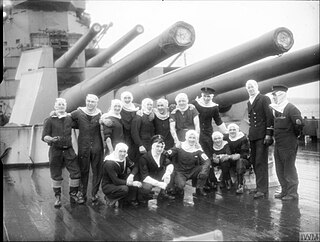
The BL 14-inch Mk VII naval gun was a breech loading (BL) gun designed for the battleships of the Royal Navy in the late 1930s. This gun armed the King George V-class battleships during the Second World War.

The St. Louis-class cruisers were a class of three cruisers that served in the United States Navy at the beginning of the 20th century. Authorized in fiscal year 1901 by an Act of Congress of 7 June 1900 as part of the naval buildup touched off by the Spanish–American War, the St. Louis-class cruiser initially began as an improved Olympia. However, during the design phase, decisions were made that increased the size of the vessel from 6,000 long tons (6,100 t) to 9,700 long tons (9,900 t), including adding protection that resulted in the designation "semi-armored cruiser". This led to a larger power plant, and other decisions were made to try to increase speed and range, such as using smaller 6-inch (152 mm) guns instead of 8-inch (203 mm) guns, and adding coal capacity. The completed ship at 9,700 long tons was the same displacement as a full armored cruiser without the same armor. One reference describes the class as "among the earliest well-documented examples of creeping growth in warship design".

The QF 4 inch Mk XVI gun was the standard British Commonwealth naval anti-aircraft and dual-purpose gun of World War II.

The 12"/50 caliber gun Mark 8 was a US naval gun mounted on the Alaska-class cruiser. The gun, like the "large cruiser" that mounted it, was intended to fill the gap between US "heavy cruisers" (6-8") and US battleships (14-16"). The name describes the size of the shells, 12 inches in diameter, and the length of the bore in calibers.

The D-class cruisers were a pair of German heavy cruisers, classified as panzerschiffe by the Reichsmarine. The ships were improved versions of the preceding Deutschland-class cruisers, authorized by Adolf Hitler in 1933. They were intended to counter a new French naval construction program. Displacement increased to 20,000 long tons (20,000 t), but Hitler allowed only increases to armor, prohibiting additions to the ships' main battery armament. Both ships were laid down in February 1934, but not much work done before work was cancelled pending a significant revision of the design. It was determined that the ships should be enlarged to counter the new French Dunkerque-class battleship. The construction contracts for both ships were superseded by the Scharnhorst-class battleships.

The 6"/53 caliber gun formed the main battery of some United States Navy light cruisers and three US submarines built during the 1920s.

The 16"/45-caliber Mark 6 gun is a naval gun designed in 1936 by the United States Navy for their Treaty battleships. It was introduced in 1941 aboard their North Carolina-class battleships, replacing the originally intended 14"/50-caliber Mark B guns and was also used for the follow-up South Dakota class. These battleships carried nine guns in three three-gun turrets. The gun was an improvement to the 16"/45-caliber Mark 5 guns used aboard the Colorado class, and the predecessor to the 16"/50-caliber Mark 7 gun used aboard the Iowa class.
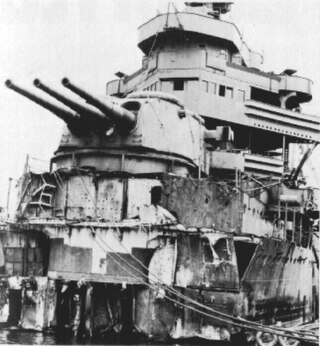
The 8"/55 caliber gun formed the main battery of United States Navy heavy cruisers and two early aircraft carriers. United States naval gun terminology indicates the gun barrel had an internal diameter of 8 inches (203 mm), and the barrel was 55 calibers long.
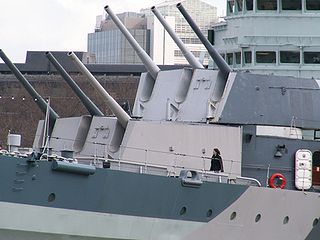
The 50-calibre BL 6-inch gun Mark XXIII was the main battery gun used on the Royal Navy and British Commonwealth's conventional (non-anti-aircraft) light cruisers built from 1930 through the Second World War, and passed into service with several other navies when ships were disposed of after the end of the War.

Third year type 20 cm/50 caliber guns formed the main battery of Japan's World War II heavy cruisers. These guns were also mounted on two early aircraft carriers, the Kaga and the Akagi before their 1935 reconstruction. The typical installation was ten 20 cm/50 guns; although Tone-class cruisers carried eight while Furutaka and Aoba-class cruisers carried six. After modernization, Akagi and Kaga carried only six, divided in three casemates per side, after the removal of the four guns in two turrets on both ships placed on the second deck.
The Neptune class was a proposed class of cruisers planned for the British Royal Navy in the latter years of the Second World War. They were large ships which were to be armed with twelve 6-inch (152 mm) dual-purpose guns and with a heavy secondary armament. Although five ships of the class were planned in 1944, they were cancelled following the end of the war and before construction could begin.
The 152 mm /53 Model 1926–1929 were built for the Italian Navy in the years before World War II. These guns were used on all Condottieri-class light cruisers except the Duca degli Abruzzi-class.

The 152 mm /55 Model 1934–1936 were built for the Italian Navy in the years before World War II. These guns were used on the Duca degli Abruzzi-class Light cruisers, which were the final series of the Condottieri-class cruisers as their primary armament and as secondary armament on the Littorio-class battleships.
